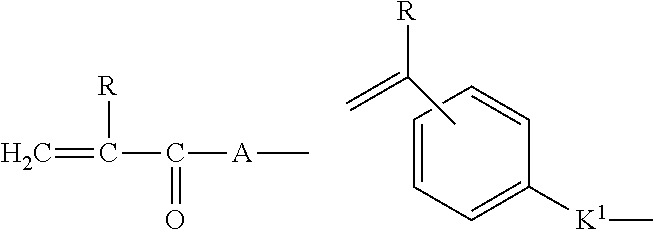Rehydratable pharmaceutical product
- Summary
- Abstract
- Description
- Claims
- Application Information
AI Technical Summary
Benefits of technology
Problems solved by technology
Method used
Image
Examples
example 1
Microsphere Production
[0072]The spheres are synthesised by a method of suspension polymerisation in which an aqueous phase comprising a solution (about 700 g) containing a PVA macromer, nelfilicon A, (around 80 g), 2-acrylamido-2-methyl propane sulphonate sodium salt (70 g) and potassium persulphate initiator (around 5 g) is suspended in an organic phase of butyl acetate (3 l) and 5 g cellulose acetate butyrate (solution in ethyl acetate) in a stirred reactor. By employing rapid mixing the aqueous phase can be dispersed to form droplets, the size and stability of which can be controlled by factors such as stirring rates, viscosity, ratio of aqueous / organic phase. Polymerisation of the dispersed monomer / macromer solution is initiated by the addition of TMEDA and raising the temperature to over 50° C. for several hours under nitrogen. After cooling to room temperature the product is purified by removing the butyl acetate by filtration followed by washing steps with solvents, vacuum dr...
example 2
[0084]The beads produced as in Example 1 are loaded with irinotecan loaded at a level of around 50 mg drug per ml beads. The lyophilisation cycle was the same as that used in example 1. The beads could easily be rehydrated upon addition of saline to the container under lower than atmospheric pressure, the beads quickly sinking and being capable of forming a homogeneous suspension.
example 3
[0085]Alginate microspheres are formed as follows. An aqueous solution of high G alginate (recovered as described in WO 00 / 09566 A) is cross-linked by spraying droplets of the 2% solution into a precipitation bath comprising a solution of calcium ions, followed by collection of the formed microspheres. The micro spheres have an average size of 215 μm (standard deviations 3 μm). After cleaning, 0.2 ml of 2% alginate microsphere suspension is transferred into a vial. Excess liquid is decanted, then 1.39 mls of 10.07 mg per ml aqueous doxorubicin solution is added to the microspheres. The mixture is shaken overnight. After this time, the loading capacity is determined by measuring the concentration of a portion of decanted excess loading solution. This reveals a loading capacity of around 50 to 60 mg doxorubicin per ml of bead suspension. Excess loading solution is removed and the bead slurry subjected to freeze drying in the vial.
[0086]The freeze drying cycle is substantially as descr...
PUM
| Property | Measurement | Unit |
|---|---|---|
| Temperature | aaaaa | aaaaa |
| Length | aaaaa | aaaaa |
| Time | aaaaa | aaaaa |
Abstract
Description
Claims
Application Information
 Login to View More
Login to View More - R&D
- Intellectual Property
- Life Sciences
- Materials
- Tech Scout
- Unparalleled Data Quality
- Higher Quality Content
- 60% Fewer Hallucinations
Browse by: Latest US Patents, China's latest patents, Technical Efficacy Thesaurus, Application Domain, Technology Topic, Popular Technical Reports.
© 2025 PatSnap. All rights reserved.Legal|Privacy policy|Modern Slavery Act Transparency Statement|Sitemap|About US| Contact US: help@patsnap.com



